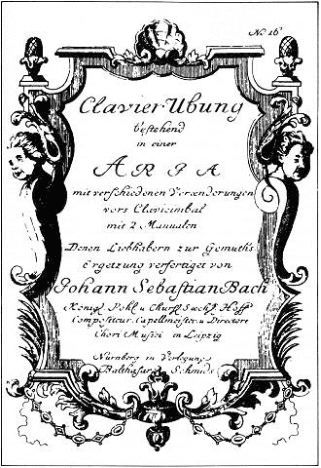J. S. Bach: Goldberg Variations, the structure
Aria with several variations (1742), BWV 988
The work was written to entertain the Russian emissary in Dresden, Keyserlingk, when he suffered from insomnia. The name of the variations goes back to Johann Gottlieb Goldberg (harpsichordist employed by the emissary at this time and a very gifted student of Bach as well as his eldest son Wilhelm Friedemann). Goldberg was a virtuoso on the piano. Therefore, Bach expected him to overcome the technically very selective variations, although he was only 14 years old at that time. Goldberg unfortunately died at the age of 29 years, however his name remains unforgotten by the following generations of musicians due to Bach's work.

|
Whether the theme (Aria) was invented by Bach himself is still being disputed among experts. However, it is already contained in the 1725 published so-called Clavierbüchlein, published 1725. The Aria is built above a chant-like bass-line, whose beginning is printed at the end of this page. The variations follow a certain, well thought-out scheme. The first two variations serve as an introduction into what follows. Then groups of three each follow afterwards. The first variation of each group (variation 3, 6,... , 27) is always a canon, whose interval to which each successive voice is transposed in relation to the preceding voice is incremented again and again as the work proceeds; that is, the follower is in the same key as the leader in number 3 (as usually practised in popular canons), in number 6 on the second, in number 9 on the third etc. The second variation of each group (variation 4, 7,... , 28), is more free and often a dance explicitly denoted as such in most cases, for example with Giga or Fughetta. The third group is usually in a virtuoso manner and of considerable technical difficulty - playing with hands crossed over occurring frequently. The variations 28 and 29 are the masterly coronation of the cycle. In the last variation, number 30, the bass-line reappears very lucidly, carrying a Quodlibet. Bach processes two well-known popular songs in a self-ironical manner. "I have not been with you for a very long time" means, the theme had not been for a long time (through all the variations) near to the bass-line. And "cabbage and turnips threw me out" means that after the many free variations it had become high time to come back to the theme. So in consequence, Bach concludes the work with an identical repetition of the Aria standing at the beginning. |
The CD (published in 2007) is available in our Web-Shop , just like the 2006 predecessor "Art of the Fugue", a double CD.
The graphics on the left denote with (1) or (2) that the variation is written for one or two manuals; in some cases, Bach himself leaves this up to the player (1 or 2). |




